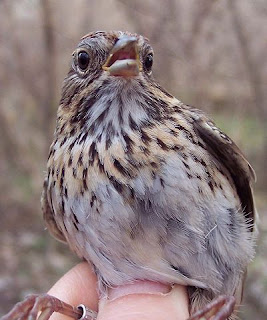It was a drizzly morning and the birds were everywhere in the bushes at Navarre. White-throated Sparrows were singing their hearts out at dawn and then about an hour after sunrise the warblers were very active despite the precipitation. The birds kept us hopping today with 273 birds with 25 recaptures in 5.25 hours. The rain shut us down at 11:30 AM or so but the birds were still moving around the station.
The number one bird remained Myrtle Warbler (Yellow-rumped) with 165 new birds banded and we had a total of 25 species banded today.
Highlights for the day were Kentucky Warbler and another Worm-eating Warbler. Today’s Myrtle count was the highest number of Myrtle Warblers we have had in several years. With the weather we have been having the past couple of days the birds are kept low and on the beach ridge.
On a side note, in a past blog I mentioned the large movements of Blue Jays I had in Navarre last week and I was sent a question about my comments regarding the Blue Jays not crossing the lake referencing the Ohio birds listserv post from South Bass Island. Some species like Turkey Vultures will cross the lake using the islands as stepping stones. The same would be true for diurnal migrants such as Blue Jays. We know that the islands are good stopover sites for migrant songbirds. So to say no birds will cross the lake is not totally correct, I meant to say they don’t prefer to cross the lake and when they do and daylight occurs those migrants will come down and stop on the islands. The islands are very important to many migratory bird species.
Top 5 species:
Myrtle (Yellow-rumped) Warbler - 165
Western Palm Warbler - 32
White-throated Sparrow - 24
Ruby-crowned Kinglet - 8
Yellow Warbler - 8
Warbler species captured: Black-and-white, Tennessee, Orange-crowned, Myrtle, Nashville, Western Palm, Yellow, Kentucky, Worm-eating Warbler, Common Yellowthroat, Northern Waterthrush, and Ovenbird.
Thrushes captured: American Robin, Wood Thrush, Hermit Thrush, and Swainson’s Thrush.


Kentucky Warbler was my favorite of the day.
Enjoy Spring!





























